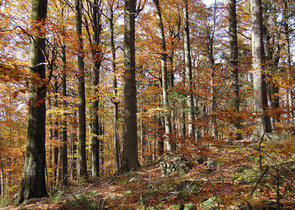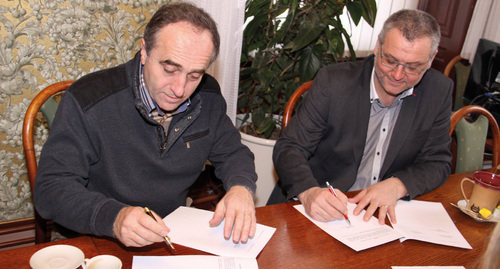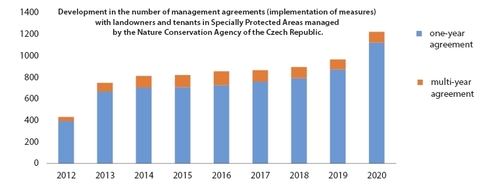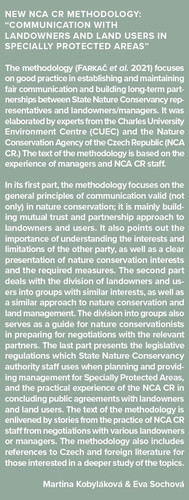Nature Conservation 2022 — 25. 5. 2022 — Nature and Landscape Management — Print article in pdf
Management Agreements: An Important Tool for Cooperation with Landowners and Land Managers in Nature

Ten years ago, the Nature Conservation Agency of the Czech Republic (NCA CR) began to conclude agreements on management through public contracts, setting up both management measures to be implemented and providing landowners or tenants with a subsidy / subvention. Consequently this practice has been step-by-step applied also by other State Nature Conservancy authorities, particularly Regional Offices. At present the agreements on management are one of the principal and commonly used tools in cooperation with land managers. The NCA CR is currently taking active steps to further expand the type of cooperation with landowners, our most important partners in practical nature conservation.
Concluding agreements on land management for nature conservation, and agreements on management in protected areas, and paying a financial contribution for its implementation has been enshrined in the Nature Conservation and Landscape Protection Act (NCLPA) since its approval, i.e. for thirty years (Article 68, para 2 and Article 69). However, the absence of general legislation on the concept of public contracts had long been an obstacle to its application in practice. This occurred only in the Administrative Procedure Code (Act No. 500/2004 Gazette), with effect from 1 January 2006. A fundamental change was also the decision of the Constitutional Court of 20101, providing a detailed interpretation of Articles 68 and 69 of the NCLPA (Hůlková 2010). Despite the fact that the legal literature is reserved for some parts of the Constitutional Court’s Plenary decision (Vomáčka et al. 2018), it undoubtedly is a breakthrough in many respects and remains essential for the implementation of practical measures for nature conservation.
In order for the NCA CR to be able to pay finan- cial contributions, it was necessary to clarify compliance with budgetary rules (Act No. 218/2000 Gazette on Budgetary Rules and on Amendments to Some Related Acts) and some other changes (for more details, see Pešout & Šmídová 2012). What is the situation after almost ten years of con- cluding and signing public agreements?
A challenging journey to agreements
The rules for concluding agreements were step-by-step established. When setting up the process, the NCA CR used the relevant interpretation of the Ministry of the Environment of the Czech Republic2; however, in order to ensure compliance with the budgetary rules, they had to build the entire system from scratch. The first step was to distinguish between commonly assigned activities in nature conservation and landscape protection and to determine the usual costs for their implementation. Today, the result are unified code lists of activities in nature conservation and landscape protection linked to costs of common measures and consequently for planning and documenting the interventions having been made in nature and the landscape (Pešout & Štěrba 2021 and this issue). Without the implementation of these demanding steps, the concluding public contracts (in particular the provision of financial contributions for the implementation of measures) would be difficult and complicated, with the risk of inefficient use of public funds3. The standardization of activities also makes it possible to develop data support tools (Zárybnický et al. 2020), which further facilitates the planning and signing agreements and their documentation in particular.
How many agreements have been signed with land managers?
Public contracts with landowners and land users have become a commonly used form for agreement on practical measures in Specially Protected Areas, as well as providing a payment for their implementation. Unfortunately, multi-annual agreements have been less common so far, although they save time and effort on administrative steps for both the NCA CR and the land manager. They are designed in such a way that unless there is a need to change the management of the objects of protection, or the budgetary possibilities of the NCA CR do not change, or there is a change on the part of the land user, there is no need to re-negotiate the activities covered by the agreement and sign a contract every year.
At present, the NCA CR concludes and signs over 1,100 agreements per year and around one hundred agreements are signed as long-term (up to ten years). The number of public contracts has been growing every year (see Figure 1).
Figure 1 Development in the number of management agreements (implementation of measures) with landowners and tenants in Specially Protected Areas managed by the Nature Conservation Agency of the Czech Republic. © Klára Čámská
The NCA CR is also gradually developing agreements on the management method in protected areas, to which no financial contribution is tied, e.g. agreements on non-intervention forests and their monitoring signed with the Forests of the Czech Republic, State Enterprise (Hort et al. 2008).
Comprehensive management agreements – all on one single paper only
The highest type of agreement with the landowner is the so-called comprehensive management agreement (Pešout et al. 2013). Its aim is to formulate clear rules and conditions for management by the owner or user. These are long-term agreements, usually for five to ten years. The comprehensive agreement includes three main parts:
Part I: Agreement on the management method This part of the agreement sets a voluntary obligation by the landowner (land user) to manage the land so that the object(s) of protection in the particular Specially Protected Area are kept in the same state or their condition improves. The NCA CR undertakes to continuously inform the owner about the state of the area, its chang- es, newly identified occurrences of specially protected and valuable species, etc. The parties agree in detail on the management principles, i.e. under what conditions the individual measures will be implemented, using specific technologies, materials and procedures, and to what deadlines. If necessary, the intensity of management, etc. can be differentiated spatially and temporally (e.g. year-on-year).
Part II: Agreement on the method of financial compensation for management difficulties
There, the NCA CR declares to the landowner (land user) the amount of financial compensation for the difficulties in agricultural, forestry or fishpond management, due to restrictions for nature conservation (Article 58 of the NCLPA) beyond the scope included in the first part of the agreement. However, it is often not possible to quantify the exact amount of losses for several years in advance, not even by the landowner; in these cases, the calculation is described in detail in the agreement. The conclusion of the agreement does not replace the legal obligation to apply for losses every year; however, the repeated providing a number of annexes is elim- inated (e.g. an extract from the Land Cadastre).
Part III: Agreement on management of specially protected areas.
In this part of the comprehensive agreement, the NCA CR agrees with the landowner (land user) on the implementation of practical measures in the field, usually resulting from the Specially Protected Area’s Management Plan, and on the amount of the financial contribution provided (pursuant to Article 69 of the NCLPA). This part of the contract includes the so-called termination provisions, where the NCA CR can notify, within a contractually stipulated deadline, that it does not have finances for the implementation of the agreed management for that year available in its budget. Then it is up to the landowners to decide whether they implement the measures on their own accord or whether it will not be implemented in the relevant year.
Of course, the agreement does not have to in- clude all three parts described above, but it is an advantage for both nature conservationists and land managers to find a consensus and conclude a comprehensive agreement. Despite the laborious process of preparation and negotiation, the result is always a time and economic saving, and better possibility of prioritization. Most importantly, there is a higher degree of understanding; firstly by the land manager, about the needs to ensure the existence of objects of protection, and secondly by the State Nature Conservancy authority, about the land manager’s abilities.
The first comprehensive management agreement is from 2013 (Pešout et al. l.c). Since then, the NCA CR has concluded and signed several of them, for example with the town of Domažlice (see photo).

As an example of a comprehensive agreement, the Nature Conservation Agency of the Czech Republic signed a public contract in 2018 with the town of Domažlice on management in municipality forests. The picture shows the then Mayor of Domažlice, Miroslav Mach (right) and NCA CR Director František Pelc. © Pavel Pešout
When does the NCA CR sign agreements outside land under its administration?
The NCA CR is authorized by the Ministry of the Environment of the Czech Republic to coordinate and ensure the implementation of action plans/ recovery programmes across the whole Czech Republic’s territory for the most threatened species. Some of the sites of these species are located outside land managed by the NCA CR. Therefore, a type of public agreement was sought there which would express the divided competence among the State Nature Conservancy authorities.
The result is a three-way comprehensive management agreement. This was signed for the first time in cooperation with the Regional Office of the Central Bohemian Region, and an enlightened owner, F. Kinský Dal Borgo. It aimed at forest management in the Dománovický les Nature Reserve, included in the Action Plan/Recovery Programme for the Scarce fritillary butterfly (Euphydryas maturna) – cf. Krása & Pavlíčko (2014). In the contract, the Regional Office acts as a locally appropriate State Nature Conservancy authority, and the NCA CR as an intervener who guarantees the payment of compensation for losses caused by difficulties of forestry manage- ment and ongoing professional support.
More management agreements
A significant increase in the percentage of management agreements within the Specially Protected Area management is one of the main aims of the integrated LIFE project “One Nature”, of which the NCA CR is a co-researcher. As part of the project activities, the capacity of the NCA CR Regional Branches has been strengthened, consultations and training sessions have been underway, a methodology for cooperation with landowners and land users has been developed for State Nature Conservancy authority staff (see Box 1), information tools are being modified (Zárybnický et al. 2020), etc. The main obstacles preventing the conclusion of agreements on a larger scale have also been identified, such as an unjustified worry that the owner loses the right to compensation if a management agreement is signed, or that the owner faces penalties for non-compliance with the contract. All unjustified concerns are explained in more detail in the mentioned methodology.
Conclusion
Management agreements arise from the mutual communication of the owner (user) of the land and the State Nature Conservancy authority. By discussing them, and subsequently signing them, a long-lasting commitment has been fulfilled which is repeated in a number of strategic documents on nature conservation and landscape protection, namely to implement nature conservation and landscape protection with the participation of landowners and land managers. Nature conservation is becoming clearer, more understandable, and predictable for partners. The comprehensive and long-term agreements on management measures in Specially Protected Areas have proved successful and therefore, it is necessary to develop this instrument further.
Acknowledgements
I would like to thank my colleagues Klára Čámská and Paula Filipová for their comments on the draft of the article. ■
Notes:
1 Decision of the Constitutional Court Pl. ÚS 8/08 on the restriction of ownership rights pursuant to Article 68 of Act No. 114/1992 Gazette on Nature Conservation and Landscape Protection (256/2010 Coll.) of 8 July 2010.
2 Communication of the State Administration and the Nature Conservation and Landscape Protection Section of the Ministry of the Environment of the Czech Republic regarding the implementation of measures to improve the natural envi- ronment pursuant to Article 68 of Act No. 114/1992 Gazette on Na ture Conservation and Landscape Protection, as amended later, Ministry of the Environment of the Czech Republic Bulletin No. 7/2014/8, entering into force 1 December 2014.
3 The costs of common measures (activities) are used as a tool to ensure the comparability of payments provided for similar activities in different regions and from different financial sources (subvention programmes/subsidy schemes). However, if the State Nature Conservancy authority is aware of a supplier who is able to implement the measure at a lower rate, the land owner/user is offered adequately lower support under the agreement. If they do not agree with it, the NCA CR will conclude a management contract with the selected cheaper supplier. Although the land owner/user has priority in ensuring the management of the Specially Protected Area, at the same time the NCA CR must proceed with due diligence and in accordance with budgetary rules and therefore cannot spend more than is necessary to implement the measures in the field.
- - -
Intro photo In 2018, the Nature Conservation Agency of the Czech Republic signed a public agreement with the town of Domažlice (western Bohemia) on management of municipality forests which, inter alia, make up the majority of the Čerchovské hvozdy National Nature Reserve. It is a comprehensive agreement formulating the principles of management, quantifies the level of compensation costs for loss caused by management difficulties, and includes an agreement on the implementation of measures to improve the condition of objects of protection in this part of the Český les Mts. Protected Landscape Area. © Jiří Sladký
- - -
Seznam literatury
Farkač B., Sochová E., Kobyláková M. (2021/v tisku): Osvědčené komunikační postupy v ochraně přírody, Metodika komunikace s vlastníky a uživateli pozemků v chráněných územích. AOPK ČR.
Hort L., Vrška T., Adam D. (2008): Výzkum lesů ponechaných přirozenému vývoji. Ochrana přírody 1/2008.
Hůlková J. (2010): Ústavní soud podpořil opatření konaná ve prospěch ochrany přírody. Ochrana přírody 65 (6): 17-18.
Krása A., Pavlíčko A. (2014): Hnědásek osikový tři roky po „vyhynutí“. Ochrana přírody 69 (1):6-9.
Pešout P., Šmídová L. (2012): Veřejnoprávní dohody s vlastníky skutečností. Ochrana přírody 67 (5):14-16.
Pešout P., Kinský dal Borgo F., Lacina D. (2013): Příklad komplexní dohody o hospodaření v chráněném území. Ochrana přírody 68 (5): 5-6.
Pešout P., Štěrba P. (2021): Standardizace péče o přírodu a krajinu. Ochrana přírody 76 (4):18-21.
Vomáčka, V., Knotek, J., Konečná, M., Hanák, J., Dienstbier, F., Průchová, I. (2018): Zákon o ochraně přírody a krajiny. Komentář. 1. vydání. Praha: C. H. Beck, s. 518.
Zárybnický J., Pešout P., Chobot K. (2020): Datová podpora veřejné správy v ochraně přírody a krajiny zajišťovaná AOPK ČR. FOP 4:6-10.



